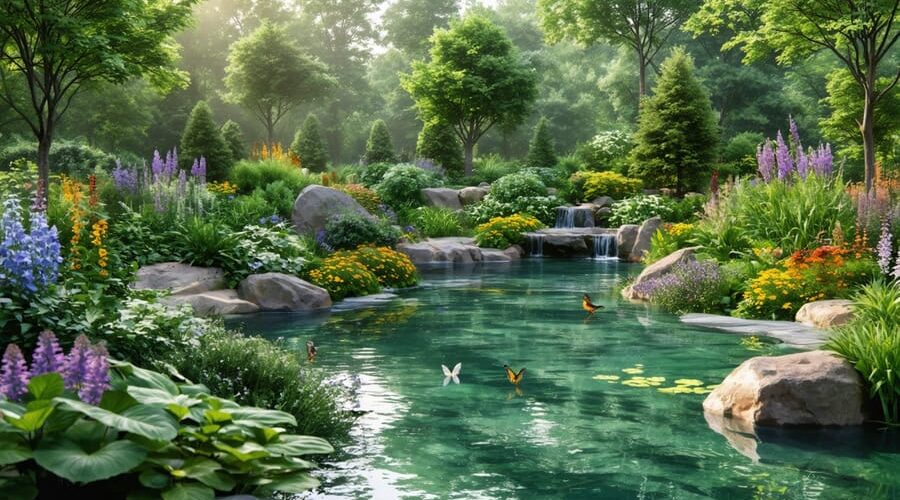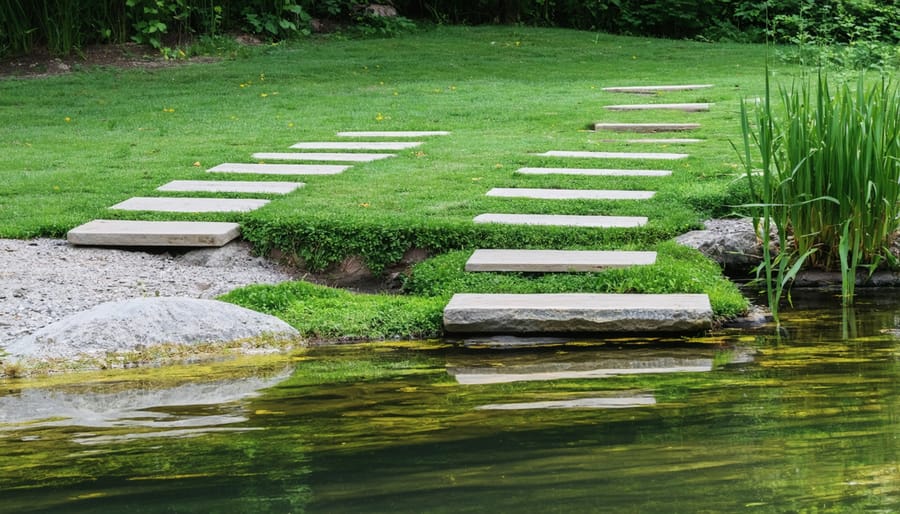
Transform Your Garden Into a Thriving Wildlife Haven (While Keeping Your Pond Perfect)
Transform your garden into a thriving ecosystem by layering native plants of varying heights, creating natural corridors for wildlife movement, and incorporating diverse water features. A well-planned garden biodiversity strategy doesn’t just make your outdoor space more beautiful – it strengthens local ecosystems and creates a self-sustaining environment that requires less maintenance over time.
From buzzing pollinators to melodious songbirds, every living thing plays a crucial role in maintaining garden health. Strategic plant placement, including ground cover, mid-height shrubs, and tall trees, provides essential habitat layers while natural water sources, from simple bird baths to flowing ponds, attract and sustain diverse wildlife populations year-round.
The secret to maximizing garden biodiversity lies in understanding the delicate balance between different species. By combining flowering plants that bloom in different seasons, installing varying water depths in ponds, and maintaining both sunny and shaded areas, you create microhabitats that support a wider range of creatures. This interconnected approach not only enhances your garden’s visual appeal but also contributes to broader environmental conservation efforts right in your backyard.

Creating Layers of Life Around Your Pond
Ground Level: Beyond Basic Ground Cover
Creating a diverse ground layer is essential for a thriving garden ecosystem. While traditional lawns have their place, mixing different low-growing plants creates a living carpet that supports local wildlife and adds visual interest. Consider incorporating native groundcovers like creeping thyme, native violets, or prostrate grevilleas, which naturally attract beneficial insects and provide shelter for small creatures.
When planning your ground cover, think in layers and zones. Start by placing low-growing plants along water-saving garden paths and around pond edges. Native grasses like weeping grass or wallaby grass work beautifully here, offering natural transition zones between different garden areas.
Don’t forget to include flowering ground covers that bloom at different times throughout the year. Native running postman, blue devil, and native mint provide food sources for pollinators while creating stunning seasonal displays. These plants also help prevent soil erosion and reduce water evaporation, making them perfect companions for water features.
For shaded areas, consider native violet, kidney weed, or native wandering jew. These hardy plants create dense coverage that suppresses weeds while providing essential habitat for beneficial insects and small reptiles. Remember to leave some bare patches with leaf litter, as these areas are crucial for ground-dwelling insects and native bees that are vital for your garden’s biodiversity.
Mid-Level: Shrubs and Small Features
The mid-level layer of your garden is crucial for creating a thriving ecosystem. Shrubs and small features serve as essential stepping stones between ground cover and taller trees, providing vital shelter and food sources for diverse wildlife.
Consider planting flowering shrubs like butterfly bush, lavender, and native viburnum species, which attract pollinators throughout different seasons. These medium-height plants create natural corridors for birds and small mammals while offering protected nesting sites.
Structural elements like log piles, rock gardens, and drought-resistant grasses add texture and create microhabitats for beneficial insects and small reptiles. Position these features strategically around your pond to create safe passages for wildlife moving between water and land.
Berry-producing shrubs such as elderberry, holly, and cotoneaster provide essential food sources during harsh winters. Mix evergreen and deciduous varieties to ensure year-round shelter and visual interest. Remember to include plants with hollow stems, which serve as homes for solitary bees and other beneficial insects.
Small water features like shallow basins or mini bog gardens complement your main pond while providing additional moisture-loving habitat spaces. These stepping-stone features help connect different areas of your garden, creating a continuous wildlife corridor that supports greater biodiversity.
For maximum impact, arrange shrubs in informal groups rather than straight lines, mimicking natural growth patterns and creating more sheltered spaces for wildlife to thrive.
Water-Friendly Wildlife Features
Natural Landing Zones
Creating safe access points around your pond is essential for wildlife to enter and exit safely. Think of these areas as wildlife-friendly ramps and beaches that connect your pond to the surrounding garden. Natural landing zones can be created using gradually sloping stones, partially submerged logs, or gently graded gravel beaches.
When designing these access points, aim to include various angles and textures. Rough surfaces provide better grip for small creatures, while smooth, slanted rocks work well for larger animals. Position these features at different points around the pond’s edge, ensuring at least one entry point faces a sheltered area of your garden where wildlife can quickly find cover.
Make sure some stones or logs extend both above and below the water’s surface. This arrangement helps amphibians like frogs and newts move between environments easily. For smaller visitors like beneficial insects, floating plants near the pond’s edge create natural bridges and resting spots.
Consider incorporating shallow areas or marshland zones using moisture-loving plants. These transitional spaces not only look beautiful but also serve as crucial habitat for various species. Position some larger rocks or logs slightly back from the water’s edge to create basking spots for reptiles and resting areas for birds.
Remember to maintain these access points by regularly checking they remain stable and clear of debris, especially after strong winds or heavy rain.

Insect Hotels and Hibernation Spots
Creating dedicated spaces for beneficial insects is one of the most rewarding ways to boost your garden’s biodiversity. Insect hotels, which can range from simple structures to elaborate multi-story designs, provide essential shelter for pollinators like solitary bees, lacewings, and ladybugs throughout the year.
To build a basic insect hotel, start with a wooden frame and fill it with natural materials. Bundle hollow bamboo stems or drill holes of varying sizes (2-8mm) in blocks of untreated wood for solitary bees. Add pine cones, small twigs, and dry leaves to create cozy spaces for beetles and other beneficial insects. Position your hotel in a sunny spot, facing southeast or southwest, and raise it slightly off the ground to prevent moisture damage.
Don’t forget about winter hibernation spots! Create brush piles using fallen branches and leaves in quiet corners of your garden. These provide excellent shelter for overwintering insects and other small wildlife. Leave some stems standing throughout winter, as many beneficial insects lay eggs in hollow plant stems.
Near your pond, consider placing flat stones or log piles that create cool, damp spaces perfect for ground beetles and other helpful predators that control garden pests. These structures also serve as stepping stones between different garden habitats, helping to create a connected ecosystem that supports year-round insect activity.

Bird-Friendly Additions
Creating a bird-friendly garden around your pond requires careful planning to ensure both feathered visitors and fish can thrive safely. Start by installing bird baths at varying heights, keeping them away from the main pond to protect your fish from predatory birds. Strategic placement of native flowering plants and berry-producing shrubs will naturally attract birds while providing natural cover for your pond inhabitants.
Consider adding specific features like shallow pebble beaches along your pond’s edge, which allow smaller birds to drink and bathe safely without accessing deeper water. Installing proper outdoor lighting for your pond not only enhances evening ambiance but also helps deter nocturnal predators.
Create vertical interest with bird-friendly structures such as feeding stations and nesting boxes, positioning them away from the pond to minimize the risk to fish. Dense shrubs and small trees near these features provide safe perches and quick escape routes for birds while maintaining a respectful distance from your water feature.
For additional protection, consider installing a pond net during sensitive seasons when predatory birds are most active. These can be tastefully concealed with climbing plants or decorative elements while still maintaining the natural aesthetic of your garden. Remember to regularly clean and maintain bird feeders to prevent debris from falling into your pond water.
Maintaining the Balance
Natural Pest Control Methods
One of the most effective ways to control garden pests naturally is by harnessing the power of biodiversity. Creating a balanced ecosystem in your garden, especially around your smart water garden features, encourages beneficial insects and wildlife that naturally keep pest populations in check.
Start by planting companion species that naturally repel unwanted insects. Aromatic herbs like lavender, mint, and rosemary not only add fragrance to your garden but also deter many common pests. Marigolds are particularly effective at protecting vegetable gardens, while nasturtiums can act as sacrificial plants, drawing pests away from your prized specimens.
Attracting beneficial insects is crucial for natural pest control. Ladybugs, praying mantises, and parasitic wasps are nature’s pest controllers, feeding on aphids, caterpillars, and other problematic insects. Plant species with small, clustered flowers like dill, fennel, and yarrow to provide these helpful insects with nectar and shelter.
Birds are also excellent allies in pest control. Install bird feeders and baths to encourage their presence, but remember to position them away from fish ponds to protect your aquatic friends. Many bird species will happily feast on slugs, snails, and various insect pests.
Creating habitat diversity is essential. Include different layers of vegetation, from ground covers to tall perennials, providing various niches for beneficial creatures. Leave some areas of your garden slightly wild, with leaf litter and hollow stems, as these serve as winter shelter for beneficial insects.
Water features play a vital role in this natural pest control system. They attract dragonflies and damselflies, which are voracious mosquito hunters. Toads and frogs, drawn to garden ponds, are excellent slug controllers. Remember to maintain chemical-free zones around water features to protect these helpful amphibians.
Seasonal Management Tips
Maintaining a biodiverse garden requires different approaches throughout the year to ensure wildlife thrives in every season. In spring, focus on creating nesting opportunities by installing bird boxes and insect hotels. This is also the perfect time to introduce new aquatic plants to your pond, following sustainable garden design principles to ensure proper placement and spacing.
Summer calls for regular maintenance while being mindful of wildlife. Trim plants in the early morning or late evening to avoid disturbing active pollinators. Keep water levels consistent in your pond, adding fresh water gradually to prevent shock to aquatic life. Create shallow areas at the pond’s edge where birds can safely drink and bathe.
As autumn approaches, resist the urge to clear away all fallen leaves – some make excellent shelter for hibernating insects and hedgehogs. However, do remove excess leaves from your pond to prevent water quality issues. Leave some seed heads standing through winter; they provide natural food sources for birds and create stunning frosted displays.
Winter is a crucial time for wildlife support. Break ice on ponds daily to ensure gas exchange for fish and amphibians, but never pour hot water directly onto frozen surfaces. Keep bird feeders well-stocked and position them near protective shrubs where birds can quickly seek shelter from predators.
Year-round, maintain a variety of habitat zones – from dense undergrowth to open sunny spots. Include plants that flower in different seasons to provide continuous food sources for pollinators. Remember that even small changes, like adding a log pile or creating a wildflower patch, can significantly boost your garden’s biodiversity while enhancing its natural beauty.
Enhancing garden biodiversity isn’t just about creating a prettier outdoor space – it’s about contributing to a healthier planet, one backyard at a time. As we’ve explored throughout this guide, a biodiverse garden supports local wildlife, creates resilient ecosystems, and brings countless moments of joy as you discover new creatures making their home in your space.
Remember, you don’t need to transform your entire garden overnight. Start with simple steps like adding a few native plants, creating a small wildlife pond, or installing a basic bug hotel. Even a single flowering plant can attract beneficial pollinators and start a chain reaction of positive changes in your garden ecosystem.
The beauty of gardening for biodiversity is that it’s a continuous journey of discovery. Each season brings new visitors and opportunities to learn about the intricate relationships between plants, insects, birds, and other wildlife. As your garden evolves, you’ll notice more butterflies visiting your flowers, birds nesting in your trees, and beneficial insects helping to control pests naturally.
Take that first step today – whether it’s leaving a patch of lawn unmowed, adding a water source for birds, or planting some pollinator-friendly flowers. Your efforts, however small, will contribute to the bigger picture of environmental conservation while creating a more engaging and vibrant garden space for you to enjoy.
